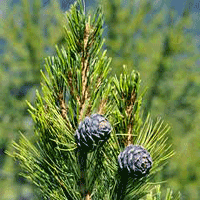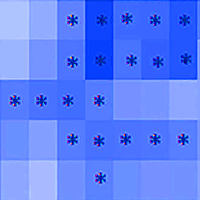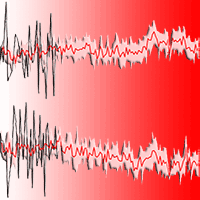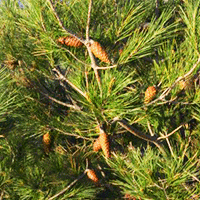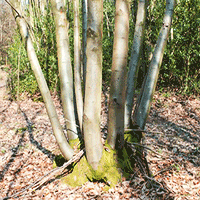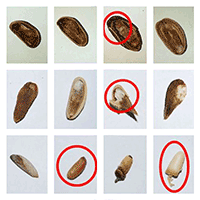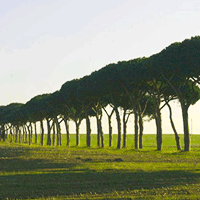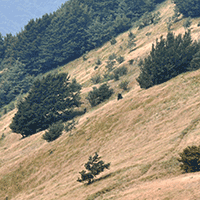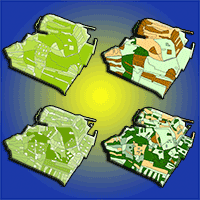
Climate change impacts on spatial distribution, tree-ring growth, and water use of stone pine (Pinus pinea L.) forests in the Mediterranean region and silvicultural practices to limit those impacts
Kaouther Mechergui (1-2), Amal Saleh Altamimi (3), Wahbi Jaouadi (1-2) , Souheila Naghmouchi (2)
iForest - Biogeosciences and Forestry, Volume 14, Issue 2, Pages 104-112 (2021)
doi: https://doi.org/10.3832/ifor3385-013
Published: Mar 01, 2021 - Copyright © 2021 SISEF
Review Papers
Abstract
Stone pine (Pinus pinea L.) has been cultivated since centuries in Mediterranean areas for its products and economic benefits, including edible pine nuts, timber, mushrooms, firewood, and grazing. However, current management objectives of stone pine stands also include recreational use, biodiversity conservation, protection from soil erosion, and CO2 fixation. Stone pine stands are considered to be among the ecosystems most vulnerable to climate change, and the current increase in drought frequency in the Mediterranean Basin has been shown to negatively impact their long-term establishment. Understanding the effects of climate change on the distribution, tree-ring growth and water use of stone pine forests can help assessing the adaptive capacity of the species, and developing management programs aimed at its conservation. This paper reviews the impacts of climate change on stone pine in the Mediterranean region. The high sensitivity of stone pine to climate change has been widely demonstrated in that: (i) climatic models predict the loss of suitable habitats and the shift of its geographical distribution in the next future; (ii) tree-ring analysis showed that winter and spring rainfalls have positive effects on growth, whereas high spring temperature has a negative effect; (iii) the strategy of stone pine to cope with water deficit affects the processes regulating its growth, including wood formation, leading to peculiar tree-ring anatomical features such as intra-annual density fluctuations. The silvicultural interventions and the most effective management strategies for stone pine forests are reviewed and discussed in the context of current climate change in the Mediterranean Basin.
Keywords
Stone Pine, Climate Change, Spatial Distribution, Tree-ring, Silvicultural Practices, Mediterranean Area
Authors’ Info
Authors’ address
Wahbi Jaouadi
Silvo-Pastoral Institute of Tabarka, B.P 328, 8110 Tabarka, University of Jendouba (Tunisia)
Wahbi Jaouadi
Souheila Naghmouchi 0000-0001-5093-810X
National Institute of Research in Rural Engineering, Waters and Forests, BP 10, Hédi Karray Street, Menzeh IV, Ariana 2080, University of Carthage (Tunisia)
Biology Department, College of Science Princess Norah Bint Abdulrahman University, Riyadh (Saudi Arabia)
Corresponding author
Paper Info
Citation
Mechergui K, Saleh Altamimi A, Jaouadi W, Naghmouchi S (2021). Climate change impacts on spatial distribution, tree-ring growth, and water use of stone pine (Pinus pinea L.) forests in the Mediterranean region and silvicultural practices to limit those impacts. iForest 14: 104-112. - doi: 10.3832/ifor3385-013
Academic Editor
Silvano Fares
Paper history
Received: Feb 25, 2020
Accepted: Dec 28, 2020
First online: Mar 01, 2021
Publication Date: Apr 30, 2021
Publication Time: 2.10 months
Copyright Information
© SISEF - The Italian Society of Silviculture and Forest Ecology 2021
Open Access
This article is distributed under the terms of the Creative Commons Attribution-Non Commercial 4.0 International (https://creativecommons.org/licenses/by-nc/4.0/), which permits unrestricted use, distribution, and reproduction in any medium, provided you give appropriate credit to the original author(s) and the source, provide a link to the Creative Commons license, and indicate if changes were made.
Web Metrics
Breakdown by View Type
Article Usage
Total Article Views: 43940
(from publication date up to now)
Breakdown by View Type
HTML Page Views: 35875
Abstract Page Views: 3751
PDF Downloads: 3615
Citation/Reference Downloads: 7
XML Downloads: 692
Web Metrics
Days since publication: 1753
Overall contacts: 43940
Avg. contacts per week: 175.46
Citation Metrics
Article Citations
Article citations are based on data periodically collected from the Clarivate Web of Science web site
(last update: Mar 2025)
Total number of cites (since 2021): 12
Average cites per year: 2.40
Publication Metrics
by Dimensions ©
Articles citing this article
List of the papers citing this article based on CrossRef Cited-by.
References
Pinus pinea in Europe: distribution, habitat, usage and threats. In: “European atlas of forest tree species” (San-Miguel-Ayanz J, de Rigo D, Caudullo G, Houston Durrant T, Mauri A eds). Publication Office of the European Union, Luxembourg, pp. 130-131.
Online | Gscholar
Tree rings indicate different drought resistance of a native (Abies alba Mill.) and a nonnative (Picea abies (L.) Karst.) species co-occurring at a dry site in Southern Italy. Forest Ecology and Management 257: 820-828.
CrossRef | Gscholar
Elevated CO2 increases tree-level intrinsic water use efficiency: insights from carbon and oxygen isotope analyses in tree rings across three forest FACE sites. New Phytologist 197: 544-554.
CrossRef | Gscholar
Studio dendroecologico su Pinus pinea L. in due differenti stazioni sulla costa mediterranea in Toscana (Italia) [Dendroecological study on Pinus pinea L. in two different stations on the Mediterranean coast in Tuscany (Italy)]. Dendrochronologia 11: 87-100. [in Italian]
Gscholar
Principais espécies florestais com interesse para Portugal -Zonas de influência Mediterrnea; Estudos e informação [Main forest species of interest to Portugal - Mediterranean influence zones; Studies and information]. Direcção Geral das Florestas, Lisboa, Portugal, pp. 77-84. [in Portuguese]
Gscholar
A review of the combination among global change factors in forests, shrublands and pastures of the Mediterranean Region: beyond drought effects. Global and Planetary Change 148 (6): 42-54.
CrossRef | Gscholar
Impact de la sécheresse sur la croissance de trois espèces forestières en Tunisie (Pinus halepensis Mill., Pinus pinea L. et Pinus pinaster Sol.) [Impact of drought on the growth of three forest species in Tunisia (Pinus halepensis Mill., Pinus pinea L. and Pinus pinaster Sol.)]. Sécheresse 18 (2): 113-121. [in French]
Online | Gscholar
Silvicultural guidelines for managing P. pinea stands in a southeastern Portuguese region for cone production. In: “Revised Silvicultural Guidelines for Selected MPT and NWFPs” (Sheppard J, Mangold L, Spiecker H eds). StarTree Deliverable 2.3, FP7 Project No 311919 KBBE 2012 (1): 2-06. European Commission, Brussels, Belgium, pp. 113.
Gscholar
La práctica de la selvicultura para la adaptación al cambio climático [The practice of forestry for adaptation to climate change]. In: “Los Bosques y La Biodiversidad Frente al Cambio Climático: Impactos, Vulnerabilidad y Adaptación en España” (Zavala MA ed). Chapter 46, Ministerio para la Transición Ecológica, Madrid, Spain, pp. 12. [in Spanish]
Gscholar
Condução de povoamentos de pinheiro manso e características nutricionais do pinhão [Driving of pine trees and nutritional characteristics of pine nuts]. Instituto Nacional dos Recursos Biológicos, IP, Oeiras, Portugal, pp. 50. [in Portuguese]
Gscholar
Europe. In: “Climate change: Impacts, adaptation, and vulnerability. Part B: regional aspects” (Barros VR, Field CB, Dokken DJ, Mastrandrea MD, Mach KJ, Bilir TE, Chatterjee M, Ebi KL, Estrada YO, Genova RC, Girma B, Kissel ES, Levy AN, MacCracken S, Mastrandrea PR, White LL eds). Contribution of working group II to the fifth assessment report of the intergovernmental panel on climate change. Cambridge University Press, Cambridge, pp. 1267-1326.
Gscholar
State of stone pine forests in Turkey and their economic importance for rural development. Options Méditerrannénnes 122: 110-117.
Gscholar
Un nuevo cultivo para Chile, el pino pinonero (Pinus pinea L) [A new crop for Chile, the stone pine (Pinus pinea L.)]. Instituto Forestal, Chile, pp. 364. [in Spanish]
Gscholar
Elementos de apoio à elaboração de projectos florestais [Elements of support for the development of forestry projects] (2nd edn). Estudos e informação 321, Direcção Geral das Florestas, Lisboa, Portugal, pp. 126. [in Portuguese]
Gscholar
Geobotanica e historia de los pinares [Geobotany and history of the pine forests]. In: “El Pino pinonero (Pinus pinea L.) en Andalucia: Ecologia, distribucion y selvicultura” (Montero G, Candela JA, Fernandez A eds). Consejeria de Medio Ambiente, Junta de Andalucia, Sevilla, Spain, pp. 49-111. [in Spanish]
Gscholar
El uso del pino piñonero como especie de frutal en sistemas agroforestales de secano [The use of stone pine as a fruit tree species in rainfed agroforestry systems]. Cuadernos de la Sociedad Española de Ciencias Forestales 22: 137-142. [in Spanish]
Gscholar
Dendroecología de Pinus pinea en el suroeste de Espana y su aplicación para elestudio de la vulnerabilidad de especies forestales ante el cambio global [Dendroecology of Pinus pinea L. in southwestern Spain and its application to study the vulnerability of forest species to global change]. In: “Actas 6° Congreso Forestal Español”, Chapter 068. Sociedad Española de Ciencias Forestales, Madrid, Spain, pp. 2-12. [in Spanish]
Gscholar
El pino pinonero árbol frutal [Stone pine fruit tree]. In: Proceedings of the “1st Symposium on Stone pine”. Valladolid (Spain), vol. 2, pp. 279-284. [in Spanish]
Gscholar
Ecologie et biogéographie des forêts du bassin Méditerranéen [Ecology and biogeography of forests in the Mediterranean basin]. Elsevier Masson, Paris, France, pp. 573. [in French]
Gscholar
Growth of Pinus pinea and Pinus halepensis as affected by dryness and marine spray in a semiarid sand dune ecosystem. Dendrochronologia 19: 211-220.
Gscholar
Disentangling the effects of competition and climate on individual tree growth: a retrospective and dynamic approach in Scots pine. Forest Ecology and Management 358: 12-25.
CrossRef | Gscholar
Le pin pignon: une espèce de choix dans le contexte des changements climatiques [Stone pine: a species of choice in the context of climate change]. Centre de Recherches Forestières, Maroc, pp. 76. [in French]
Gscholar
Integrating infra-specific variation of Mediterranean conifers in species distribution models. Applications for vulnerability assessment and conservation. PhD thesis, Universidad de Valladolid, Spain, pp. 284.
Gscholar
Etude dendroclimatologique de quatre populations de pin pignon en Tunisie [Dendroclimatological study of four pine populations in Tunisia]. Forêt Méditerrannenne 28 (3): 219-228. [in French]
Gscholar

